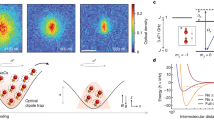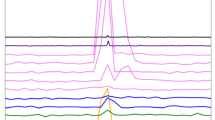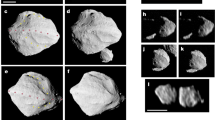Abstract
The existence of binary stars in globular clusters has a long history of controversy1–3. At present the only evidence for binaries in globular clusters comes from binaries in extreme states: cataclysmic variables4,5 and X-ray sources (see refs 6 and 7 for reviews, and ref. 8 for new observations of very weak X-ray sources). The existence of the latter is customarily ascribed to tidal capture of red dwarf companions by neutron stars (or possibly solar-mass black holes)9. In fact, tidal capture should be at least as effective in creating close binaries comprising two main-sequence stars9,10. Subsequent evolution of such binaries is very likely to lead to mass exchange between the two, and possibly merger. In conventional calculations, gravitational radiation drives the binary orbital evolution11,12; recently, it has been shown that in the denser globular clusters, where tidal capture is most effective, gravitational encounters with passing field stars also have an important role, both by slow, cumulative compression of the binary orbit, and by occasional catastrophic physical collisions13. On the basis of these mechanisms, we predict that globular clusters should contain substantial numbers of: close binaries; low-mass contact binaries, perhaps similar to the somewhat more massive WUMa stars; and ‘blue stragglers’, stars lying on the extrapolated main sequence beyond the turn-off. These objects should be most common in the densest regions of the Galaxy's globular cluster system.
This is a preview of subscription content, access via your institution
Access options
Subscribe to this journal
Receive 51 print issues and online access
$199.00 per year
only $3.90 per issue
Buy this article
- Purchase on Springer Link
- Instant access to full article PDF
Prices may be subject to local taxes which are calculated during checkout
Similar content being viewed by others
References
Trimble, V. Bull. Am. astr. Soc. 8, 443 (1976).
Gunn, J. E. & Griffin, R. F. Astr. J. 84, 752 (1979).
Spitzer, L. Jr & Mathieu, R. D. Astrophys. J. 241, 618 (1980).
Gunn, J. E., Margon, B. & Downes, D. Astrophys. J. Lett. 247, L89 (1981).
Webbink, R. IAU Symp. No. 88, 561–565 (1980).
Lewin, W. H. G. & Joss, P. C. in Accretion-Driven Stellar X-Ray Sources (eds Lewin, W. H. G. & van den Heuvel, E. P. J) (Cambridge University Press, 1983).
Trimble, V. IAU Symp. No. 85, 259–279 (1980).
Hertz, P. & Grindlay, J. Astrophys. J. Lett. 267, L83 (1983).
Fabian, A., Pringle, J. & Rees, M. Mon. Not. R. astr. Soc. 172, 15p (1975).
Press, W. H. & Teukolsky, S. A. Astrophys. J. 213, 183 (1977).
Paczynski, B. Acta astr. 17, 287 (1967).
Faulkner, J. Astrophys. J. Lett. 170, L99 (1971).
Krolik, J. H., Meiksin, A. & Joss, P. C. Astrophys. J. (submitted).
Krolik, J. H. Astrophys J. (submitted).
Hills, J. G. & Day, C. A. Astrophys. Lett. 17, 87 (1976).
Verbunt, F. & Zwaan, C. Astr. Astrophys. 100, 67 (1981).
Patterson, J. Astrophys. J. Suppl. (submitted).
Rappaport, S. A., Verbunt, F. & Joss, P. C. Astrophys. J. (in the press).
Spruit, H. C. & Ritter, H. Astrophys. J. (submitted).
Taam, R. Astrophys. J. 268, 361 (1983).
Colgate, S. A. Astrophys. J. 150, 163 (1967).
Seidl, F. G. P. & Cameron, A. G. W. Astrophys. Space. Sci. 15, 44 (1972).
Flannery, B. & Johnson, C. Astrophys. J. 263, 266 (1982).
Peterson, C. J. & King, I. R. Astr. J. 80, 427 (1975).
Bahcall, N. A. Astrophys. J. Lett. 204, L83 (1976).
Bahcall, N. A. & Hausman, M. A. Astrophys. J. Lett. 207, L81 (1976).
Malkan, M., Kleinmann, D. E. & Apt, J. Astrophys J. 237, 432 (1980).
Lightman, A. P. & Shapiro, S. L. Rev. mod. Phys. 50, 437 (1978).
Webbink, R. F. Astrophys. J. 227, 178 (1979).
King, I. R. Astr. J. 67, 471 (1962).
Trimble, V. Mon. Not. R. astr. Soc. 178, 335 (1977).
Anderson, L. & Shu, F. H. Astrophys. J. Suppl. 40, 667 (1979).
Spitzer, L. Jr & Härm, R. Astrophys. J. 127, 544 (1958).
Heggie, D. C. Mon. Not. R. astr. Soc. 173, 729 (1975).
Cohn, H. astrophys J. 234, 1036 (1979).
Author information
Authors and Affiliations
Rights and permissions
About this article
Cite this article
Krolik, J. Main-sequence binaries, contact binaries, and blue stragglers in globular clusters. Nature 305, 506–508 (1983). https://doi.org/10.1038/305506a0
Received:
Accepted:
Issue Date:
DOI: https://doi.org/10.1038/305506a0
Comments
By submitting a comment you agree to abide by our Terms and Community Guidelines. If you find something abusive or that does not comply with our terms or guidelines please flag it as inappropriate.



